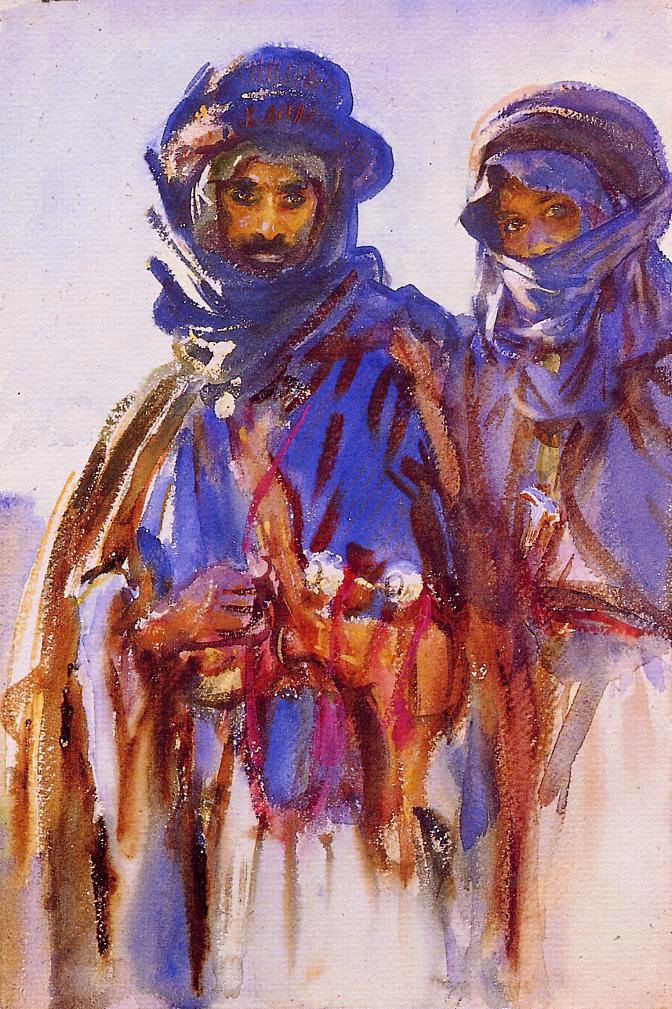 |
| Dans les oliviers, 1878 by John Singer Sargent |
Impressionism
If I had to pick between Impressionism or Post Impressionism, I would pick Impressionism. Impressionist paintings have characteristics which include a fluidity of movement, short, thin visible brush strokes, various angles, and show the play of light on the subject matter. ("Impressionism"). One of the Impressionist painters I really like is John Singer Sargent. Though he is in the Impressionism category, I find his paintings to be slightly different than those of Claude Monet and Pierre-Auguste Renoir. His depictions are still clearly defined, without losing his images in the soft painted colors. The painting pictured to the left is one of my favorites, among many, of his. The colors are muted, almost dull with the soft and quick strokes of the brush, depicting the Impressionist style. I also liked how he painted the woman from behind, as if she doesn't know he is there, which showcases the Impressionist style of capturing a quick moment, as if he took a picture just as she leaned against the branch. It has a dream-like quality which I like. Another painting by Singer, which is slightly different in composition, is Ellen Terry as Lady Macbeth, 1889, pictured below on the left. |
| Ellen Terry as Lady Macbeth, 1889 by John Singer Sargent |
 |
| Ophelia, 1851 by John Everett Millais |
 |
| Bedouins, 1905-06 by John Singer Sargent |
Post Impressionism
My feelings on Post-Impressionism is that I do not care for the way they are painted. I find them to be too simple for my taste, especially the focused used on shapes to distort form and opening up the picture to a more personal interpretation. I find my dislike to these Post-Impressionist painters funny when compared to the sentiments of landscape painter and art teacher Joseph Vincent on his initial "impression" of Renoir's The Dancer, quoted in the french magazine Clarivari as saying, "What a pity-that the painter, who has a certain understanding of color, doesn't draw better; his dancer's legs are as cottony as the gauze of her skirts" ("How the impressionists got their name"). |
| The Dancer, 1874 by Pierre-Auguste Renoir |
 |
| The Yellow Christ, 1889 by Paul Gauguin |
 |
| Bathers at Asnières, 1883-84 by George Seurat |
 |
| A Sunday Afternoon on the Island of la Grand Jatte, 1886 by George Seurat |
Aesthetics
I think my personal aesthetic taste prefers artworks with depth, colors, and detailed lines and features. Sargent's use of colors in both oils and watercolors and the way he provides motion to his subjects, Renoir's soft mix of colors and hues, and George Seurat's ability to use colors and extremely tiny brushstrokes to create crisp lines all show a difficult skill of workmanship. One of the modern works I researched was similar to the Post-Impressionist movement because of its use of shapes and short strokes, which is used by just a palette knife instead of a brush. |
| City by the Lake, Boca Raton n.d., Leonid Afremov |
I find these colors in City by the Lake, by Leonid Afremov, to be reminiscent of the watercolor picture of the Bedouins by Sargent. You can see the sharp square strokes of the knife, and how the images are strongly defined against the canvas. Breathtaking.
Works Cited
"Bathers at Asnières." georgeseurat.org. georgeseurat.org. 2015. Web. 23 Mar. 2015. http://www.georgesseurat.org/Bathers-At-Asnieres-1883-84-large.html "Bedouins." Wikipedia. Wikimedia Foundation, 18 May 2014. Web. 23 Mar. 2015. http://commons.wikimedia.org/wiki/File:Bedouins_John_Singer_Sargent.jpeg
"City by the Lake." afremov.com. afremov.com. 2014. Web. 23 Mar. 2015. http://afremov.com/CITY-BY-THE-LAKE-PALETTE-KNIFE-Oil-Painting-On-Canvas-By-Leonid-Afremov-Size-30-x40.html
"Dans les oliviers." Wikipedia. Wikimedia Foundation, 1 Dec. 2013. Web. 23 Mar. 2015. http://commons.wikimedia.org/wiki/File:Dans_les_oliviers.jpg
"Ellen Terry as Lady Macbeth." Wikipedia. Wikimedia Foundation, 5 Nov. 2014. Web. 23 Mar. 2015. http://commons.wikimedia.org/wiki/File:Ellen_Terry_as_Lady_Macbeth.jpg
"How Impressionists got their name." khanacademy.org. Khan Academy, 8 May 2014. Web. 23 Mar. 2015. https://www.khanacademy.org/humanities/becoming-modern/avant-garde-france/impressionism/a/how-the-impressionists-got-their-name
"Impressionism." Wikipedia. Wikimedia Foundation, 26 Feb. 2015. Web. 23 Mar. 2015. http://en.wikipedia.org/wiki/Impressionism
"Ophelia." Wikipedia. Wikimedia Foundation, 10 Jan. 2015. Web. 23 Mar. 2015. http://commons.wikimedia.org/wiki/File:John_Everett_Millais_-_Ophelia_-_Google_Art_Project.jpg
"Paul Cézanne's Approach to Watercolor." khanacademy.org. Khan Academy, 8 May 2014. Web. 23 Mar. 2015. https://www.khanacademy.org/humanities/becoming-modern/avant-garde-france/post-impressionism/v/paul-cezanne-approach-watercolor
"Sunday Afternoon on the Island of la Grand Jatte." georgeseurat.org. georgeseurat.org. 2015. Web. 23 Mar. 2015. http://www.georgesseurat.org/Sunday-Afternoon-on-the-Island-of-la-Grande-Jatte--1886.html
"The Dancer." National Gallery of Art. NGA.gov, n.d. Web. 23 Mar. 2015. https://images.nga.gov/en/search/do_quick_search.html?q=%221942.9.72%22
"The Yellow Christ." Wikipedia. Wikimedia Foundation, 22 Feb. 2015. Web. 23 Mar. 2015. http://en.wikipedia.org/wiki/Paul_Gauguin#/media/File:Gauguin_Il_Cristo_giallo.jpg
I liked that you compared Impressionism with Post-Impressionism. I think the differences between the two styles were subtle yet drastic. I agree that Impressionism is the more appealing choice between the two and that there is just something about the Post-Impressionism that makes it less interesting to look at. The last picture you posted, the "City by the Lake", is such a fantastic picture to me. I know it is similar to Post-Impressionist work but the colors and the reflections from the water are so beautiful to me. In my post I talked about Monet's "Water Lilies" and the same concept of water was one that really appeals to me. Great blog!
ReplyDelete